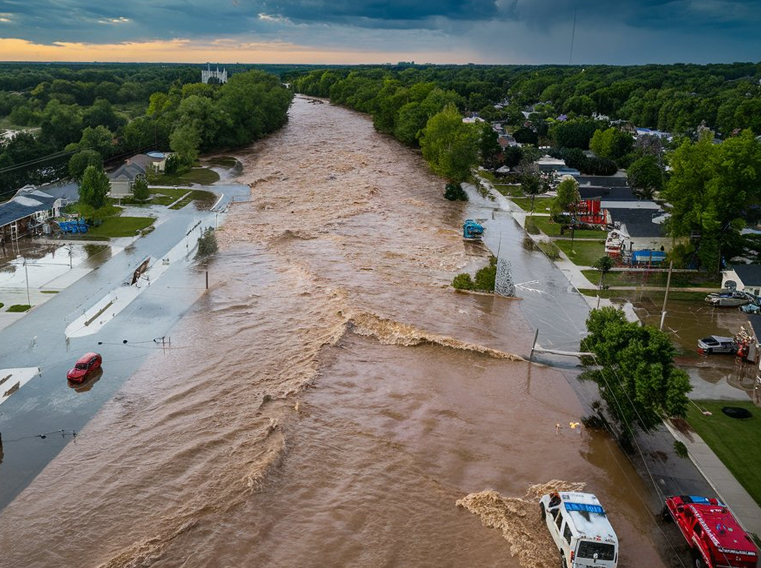From artisanal crepes to rebellious cheesecake waffles, Reading's breakfast rebels are transforming morning meals. These seven spots will revolutionize how you start your day.
As torrential rain continues to batter Berkshire, residents are on high alert following the government's latest flood warnings. The persistent downpours have saturated the region, prompting officials to release an updated list of at-risk areas. With local rivers and streams swelling beyond their banks, communities are scrambling to protect properties and infrastructure. The warnings come as meteorologists predict another 48 hours of heavy precipitation, potentially exacerbating an already precarious situation. Local authorities are urging residents to stay informed and take necessary precautions as the county faces one of its wettest periods in recent memory.
Latest Flood Warnings Issued as Berkshire Faces Deluge

The UK government has released an updated list of flood warnings for Berkshire as the region grapples with relentless rainfall. The warnings come in response to a significant meteorological event that has seen the county experience one of its wettest periods in recent years. Local authorities are closely monitoring the situation as rivers and streams across Berkshire approach dangerous levels.
The Environment Agency has identified several high-risk areas, with particular concern for low-lying regions near the River Thames and its tributaries. Communities in Reading, Maidenhead, and Windsor are on high alert, with residents advised to take immediate action to protect their properties. The warnings extend to smaller watercourses as well, including the River Loddon and the River Kennet, which have seen rapid increases in water levels over the past 48 hours.
Local emergency services have been mobilised, with Berkshire Fire and Rescue Service deploying additional resources to assist with potential evacuations and flood mitigation efforts. Sandbag distribution centres have been established in key locations, providing residents with essential materials to defend their homes against rising waters.
Paul King, a spokesperson for the Berkshire Flood Resilience Forum, stated, "We're urging all residents in flood-prone areas to stay vigilant and follow the latest guidance. This is a dynamic situation, and conditions can change rapidly."
Community Impact and Long-Term Concerns
The persistent rainfall and subsequent flood warnings have sparked concerns about the long-term impact on Berkshire's communities. Local businesses, particularly those in flood-prone areas, are bracing for potential disruptions and financial losses. The agricultural sector, a significant contributor to the county's economy, faces the prospect of waterlogged fields and damaged crops if the deluge continues.
Environmental experts are also raising alarms about the potential ecological consequences of prolonged flooding. Dr. Emma Thompson, an ecologist at the University of Reading, explains, "Excessive flooding can lead to soil erosion, contamination of water sources, and disruption of local ecosystems. We're particularly concerned about the impact on wildlife habitats along the Thames Valley."
The current situation has reignited debates about flood management and infrastructure resilience in Berkshire. Local councillors are facing increased pressure to accelerate flood defence projects and improve drainage systems across the county. There are calls for a comprehensive review of urban planning policies to ensure future developments are better equipped to handle extreme weather events.
As Berkshire residents prepare for more challenging days ahead, there's a growing sense of community solidarity. Local volunteer groups have mobilised to support vulnerable neighbours, demonstrating the resilience that has become characteristic of the region in times of crisis. While the immediate focus remains on weathering the current storm, the events of this winter are likely to have lasting implications for how Berkshire approaches flood risk management in the years to come.
A Watershed Moment for Berkshire's Flood Resilience
As Berkshire grapples with its most severe deluge in recent memory, the county finds itself at a critical juncture. The relentless rainfall and subsequent flood warnings have not only tested the region's immediate crisis response but have also laid bare the urgent need for long-term resilience planning.
This watershed moment presents both challenges and opportunities for Berkshire. On one hand, the flooding threatens to inflict significant economic damage, particularly to local businesses and the agricultural sector. However, it also offers a compelling catalyst for change, potentially driving innovations in flood management and urban planning.
The crisis has ignited a renewed sense of community spirit, with volunteer groups rallying to support vulnerable residents. This grassroots mobilisation could serve as a blueprint for future community-led resilience initiatives. Moreover, the flooding has thrust environmental concerns into the spotlight, potentially accelerating the adoption of nature-based solutions and sustainable drainage systems.
As Berkshire looks to the future, the question remains: will this event mark a turning point in the county's approach to flood risk management? The coming months will be crucial in determining whether lessons learned translate into concrete action. How will local authorities, businesses, and residents work together to build a more flood-resilient Berkshire? The answers to these questions will shape the county's landscape and communities for generations to come.